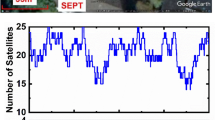Abstract
The Chinese Beidou system, also known as Compass, has entered its trial operational stage and can already provide services for triple-frequency users. Using triple-frequency signals is expected to be of great benefit for ambiguity resolution. Based on error characteristic analysis of the Beidou frequencies, we introduce the procedure of selecting the best combinations of triple-frequency signals. The geometry-based model and geometry-free model of triple-frequency signals are presented. Three triple-frequency carrier ambiguity resolution (TCAR) methods are described, which include the cascading rounding method, the stepwise AR method and the modified stepwise AR method. In order to evaluate the performance of these methods, observations from baselines of various lengths were collected using Beidou triple-frequency receivers and were processed epoch-by-epoch using the three methods. The same observation data were also processed in a dual-frequency mode for comparison. The results show that, compared to the dual-frequency based solution, the single epoch ambiguity resolution success rate with triple frequency improved nearly 30 % for the short baselines (<20 km) and 100 % for the mid-length baselines (20–50 km) using the proposed modified stepwise AR method.
Similar content being viewed by others
Explore related subjects
Discover the latest articles, news and stories from top researchers in related subjects.References
Feng Y (2008) GNSS three carrier ambiguity resolution using ionosphere-reduced virtual signals. J Geodesy 82(12):847–862
Feng Y, Li B (2008) A benefit of multiple carrier GNSS signals: regional scale network-based RTK with doubled inter-station distances. J Spatial Sci 53(2):135–148
Feng Y, Li B (2009) Three carrier ambiguity resolutions: generalised problems, models and solutions. J Glob Position Syst 8(2):115–123
Forssell B, Martin-Neira M, Harris R (1997) Carrier phase ambiguity resolution in GNSS-2. Proceedings of the ION GPS-1997, Institute of Navigation, Kansas City, MO, pp 1727–1736
Han S, Rizos C (1999). The impact of two additional civilian GPS frequencies on ambiguity resolution strategies. Proceedings of ION 55th annual meeting, Institute of Navigation, Cambridge, MA, pp 315–321
Hatch R (1996) The promise of a third frequency, GPS world, May 1996, pp 55–58
Hatch R, Jung J, Enge P et al (2000) Civilian GPS: the benefits of three frequencies. GPS Solut 3(4):1–9
Jung J (1999) High integrity carrier phase navigation for future LAAS using multiple civilian GPS signals. Proceedings of the ION GPS-1999, Institute of Navigation, Nashville, Tennessee, Alexandria, pp 14–17
Jung J, Enge P, Pervan B (2000) Optimization of cascade integer resolution with three civil GPS frequencies. Proceedings of the ION GPS-2000, Institute of Navigation, Salt Lake City, UT, pp 2191–2200
Leick A (2003) GPS satellite surveying, 3rd edn. Wiley, New York
Li B (2008) Generation of third code and phase signals based on dual-frequency GPS measurements. Proceedings of the ION GNSS-2008, Institute of Navigation, Savannah, GA, USA, pp 2820–2830
Teunissen PJG (1995) The least-squares ambiguity decor relation adjustment: a method for fast GPS integer ambiguity estimation. J Geodesy 70(1):65–82
Teunissen PJG (1999) An optimality property of the integer least-squares estimator. J Geodesy 73:587–593
Teunissen PJG, Joosten P, Tiberius C (2002) A comparison of TCAR, CIR and lambda GNSS ambiguity resolution. Proceedings of the ION GPS-2002, Institute of Navigation, Portland, OR, pp 2799–2808
Verhagen S (2005) On the reliability of integer ambiguity resolution. Navigation 52(2):99–110
Vollath U, Birnbach S, Landau H, Freile-ordonez JM, Martin-Neira M (1998) Analysis of three-carrier ambiguity resolution (TCAR) technique for precise relative positioning in GNSS-2. Proceedings of the ION GPS-1998, Institute of Navigation, Nashville, TN, pp 417–426
Acknowledgments
The work is partially sponsored by Natural Science Foundation of China (grant no. 41004014), partially sponsored by National 863 Project of China (2012AA12A202), and partially supported by “the Fundamental Research Funds for the Central Universities (No. 2012214020208)”. The authors are very grateful to the anonymous reviewers for their constructive comments and suggestions.
Author information
Authors and Affiliations
Corresponding author
Rights and permissions
About this article
Cite this article
Tang, W., Deng, C., Shi, C. et al. Triple-frequency carrier ambiguity resolution for Beidou navigation satellite system. GPS Solut 18, 335–344 (2014). https://doi.org/10.1007/s10291-013-0333-9
Received:
Accepted:
Published:
Issue Date:
DOI: https://doi.org/10.1007/s10291-013-0333-9




